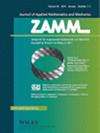Conjugate dissipative radiative heating with thermal slipping and the entropy production on the thrust of MHD gold blood nanofluid with curvature effects
IF 3.2
4区 工程技术
Q1 MATHEMATICS, APPLIED
Zamm-zeitschrift Fur Angewandte Mathematik Und Mechanik
Pub Date : 2023-09-26
DOI:10.1002/zamm.202300260
引用次数: 0
Abstract
Abstract This article analyzes the impact of conjugated dissipative radiative heat transfer with heat source/sink, thermal slip, and the transverse magnetic field on the behavior of the magnetohydrodynamic (MHD) peristaltic thrust containing ferromagnetic gold nanoparticles (AuNPs) with different shape factors through the non‐Newtionian blood flow within compliant walls tube. Entropy generation (EG) plays a prominent role in all aspects connected to thermodynamics and heat transfer aiding in the identification and reduction of system irreversibilities. The sources of irreversibility stem from dissipative friction inherent in fluid flow, the presence of a magnetic field, and the heat transfer process. The ferromagnetic gold nanoparticles (AuNPs) exhibit diverse shapes (bricks, cylinders, and platelets) and possess both magnetic and thermal attributes thereby enhancing the efficiency of heat transfer process. The peristaltic thrust drives the dynamic behavior of the gold blood nanofluid through a compliant tube. The tube walls are flexible and exhibit a curvature effects that can alter the dynamics of fluid flow. The effective Hamilton‐Crosser model is selected to express the thermal conductivity of the nanofluid. Gold blood nanofluids can be treated as incompressible, non‐Newtonian, and MHD fluid flow. The governing equations of the system are solved using the perturbation approach under the assumptions of low Reynolds numbers and long wavelength. Hybrid interactions of magnetic field, radiative heating, thermal slip, elastic wall properties, and gold nanoparticles shapes and concentrations are investigated within the gold blood nanofluid flow. The resulting graphs include the profiles of velocity, temperature distributions, EG, and irreversibility parameters under the influence of the above parameters. The findings reveal that the overall EG rises with increasing values of heat source intensity, Brinkman number, temperature difference factor, compliant wall curvature coefficient, and gold nanoparticles concentrations. Additionally, it is observed that an increase in magnetic flux strength results in the emergence of reversal flow patterns near the walls. This arises due to the augmented magnetic flux obstructing the peristaltic nanofluid flow leading to reduce streamwise velocity. Moreover, heightened magnetic flux strength causes temperature reduction for both thermal slip and non‐slip conditions. Generally, the presence of a thermal slipping parameter further enhances the distribution of temperature. In essence, the rationale and significance of this study primarily revolve around comprehending the interplay of these diverse factors with MHD peristaltic motion of gold blood nanofluid and EG. This not only furthers our theoretical understanding of complex systems but also has practical implications that can improve new technologies, processes, and medical applications. For example, in medical treatments like photothermal therapy (PPT), insights gained from this research can help in developing more effective and precise treatment methods. By understanding the impact of these factors on EG, new ways can be identified to minimize or manage system inefficiencies leading to more sustainable and optimized treatment processes. This research holds promise for application in cancer detection and treatment by employing a combination of PPT and magnetic hyperthermia. This entails dispersing AuNPs into the blood circulation through arteries and blood vessels and subsequently applying photothermal radiation and a magnetic field.带热滑移的共轭耗散辐射加热及曲率效应下MHD金血纳米流体推力的熵产
摘要本文分析了热源/散热器、热滑移和横向磁场的共轭耗散辐射换热对含不同形状因子的铁磁金纳米颗粒(AuNPs)通过柔性壁管内非牛顿式血流的磁流体动力学(MHD)蠕动推力行为的影响。熵产生(EG)在与热力学和传热有关的所有方面都起着重要作用,有助于识别和减少系统的不可逆性。不可逆性的来源源于流体流动中固有的耗散摩擦、磁场的存在和传热过程。铁磁性金纳米颗粒(AuNPs)具有多种形状(砖状、圆柱形和片状),并具有磁性和热特性,从而提高了传热过程的效率。蠕动推力驱动金血纳米流体通过柔性管的动态行为。管壁是灵活的,并表现出曲率效应,可以改变流体流动的动力学。选择有效的Hamilton - Crosser模型来表示纳米流体的导热性。金血液纳米流体可以被视为不可压缩、非牛顿流体和MHD流体流动。在低雷诺数和长波长的假设下,用摄动法求解了系统的控制方程。在金血纳米流体流动中,研究了磁场、辐射加热、热滑移、弹性壁特性以及金纳米颗粒形状和浓度的混合相互作用。所得图形包括在上述参数影响下的速度分布、温度分布、EG和不可逆性参数的分布。结果表明:随着热源强度、Brinkman数、温差系数、柔顺壁曲率系数和金纳米颗粒浓度的增大,整体EG值增大;此外,还观察到磁通量强度的增加会导致壁面附近出现反转流型。这是由于增强的磁通量阻碍了蠕动纳米流体的流动,导致流向速度降低。此外,在热滑移和非滑移条件下,磁通量强度的提高会导致温度的降低。一般来说,热滑移参数的存在进一步增强了温度的分布。从本质上讲,本研究的基本原理和意义主要围绕着理解这些不同因素与金血纳米流体和EG的MHD蠕动运动的相互作用。这不仅进一步加深了我们对复杂系统的理论理解,而且具有实际意义,可以改进新技术,工艺和医疗应用。例如,在光热疗法(PPT)等医学治疗中,从这项研究中获得的见解可以帮助开发更有效和精确的治疗方法。通过了解这些因素对EG的影响,可以确定新的方法来最大限度地减少或管理系统效率低下,从而实现更可持续和优化的处理过程。本研究将PPT与磁热疗结合应用于癌症的检测和治疗。这需要通过动脉和血管将aunp分散到血液循环中,随后施加光热辐射和磁场。
本文章由计算机程序翻译,如有差异,请以英文原文为准。
求助全文
约1分钟内获得全文
求助全文
来源期刊
CiteScore
3.30
自引率
8.70%
发文量
199
审稿时长
3.0 months
期刊介绍:
ZAMM is one of the oldest journals in the field of applied mathematics and mechanics and is read by scientists all over the world. The aim and scope of ZAMM is the publication of new results and review articles and information on applied mathematics (mainly numerical mathematics and various applications of analysis, in particular numerical aspects of differential and integral equations), on the entire field of theoretical and applied mechanics (solid mechanics, fluid mechanics, thermodynamics). ZAMM is also open to essential contributions on mathematics in industrial applications.

 求助内容:
求助内容: 应助结果提醒方式:
应助结果提醒方式:


